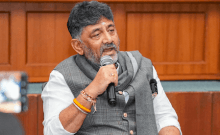
India stands at a defining crossroads in 2025, its $4.1 trillion economy and burgeoning global influence heralding a nation poised to redefine the essence of great power status. I see India not as a hegemon seeking dominance nor a peripheral player confined to regional concerns, but as a keystone power a dynamic force that stabilizes a fractured global order through economic resilience, strategic agility, and moral leadership. Like the keystone in an architectural arch, India holds disparate forces together, mediating between developed and developing worlds, balancing rivalries, and forging equitable norms in trade, technology, and climate governance.
This vision traces India's ascent from its present strengths a vibrant digital economy, a youthful demographic, and a flexible foreign policy to a transformative role by 2047, when it will anchor a multipolar Asia and offer a universal model for rising powers. The journey is fraught with challenges, from internal inequalities to external rivalries, yet through disciplined reforms and bold innovation, India can shape a balanced, prosperous future, inviting global partnership in its ascent.
Economic engine: Powering the ascent
India's economic ascent is the bedrock of its keystone ambition, propelled by a $4.1 trillion economy growing at 6-7% annually, outpacing most global peers.
By 2030, India is projected to surpass Japan and Germany, becoming the world's third-largest economy, with a trajectory toward a $10 trillion GDP by 2040. Its digital ecosystem is a global pacesetter: the Unified Payments Interface (UPI) processes 50% of the world's digital transaction volume, facilitating billions of seamless exchanges, while India Stack empowers 1.4 billion citizens with interoperable digital identity and payment systems. Strategic sectors - semiconductors, renewable energy, and defense, are driving this transformation. India aims to capture 10% of global semiconductor production by 2035, harnessing its $50 billion Production-Linked Incentive (PLI) schemes to build foundries and design hubs.
Its renewable energy target of 500 gigawatts by 2030, coupled with green hydrogen initiatives, positions it as a leader in the global energy transition. Defense exports, valued at $2.5 billion in 2025, are projected to reach $10 billion by 2035, with indigenous platforms like BrahMos missiles gaining traction in markets from Armenia to the Philippines.
This economic dynamism is fueled by a demographic dividend. India's median age of 28 and a 600 million-strong workforce offer unmatched potential for consumption and innovation. Annual foreign direct investment inflows of $80 billion, bolstered by free-trade agreements with the United Kingdom, European Union, and Australia finalized or advanced in 2025, signal growing global confidence.
The "Make in India" initiative has elevated manufacturing to 17% of GDP, with a clear path to 25% by 2035, driven by electronics and aerospace exports. India's leadership in pharmaceuticals, supplying 20% of global generics, and digital public goods, such as Aadhaar and CoWIN, positions it to diversify supply chains away from China, forging partnerships with ASEAN, Africa, and Latin America. Yet, structural challenges threaten this trajectory.
A per capita GDP of approximately $2,900, compared to China's $12,500, reflects stark inequality, with a Gini coefficient of 0.35. Infrastructure deficits demand $1.5 trillion by 2035, while protectionist trade policies limit India's global trade share to 2%. Youth unemployment, affecting 25% of the workforce, and a mere 5% of workers possessing formal training underscore the urgency of upskilling 400 million individuals by 2030. External vulnerabilities, including a $100 billion trade deficit with China and exposure to global shocks energy price spikes or climate adaptation costs estimated at $500 billion by 2040 further complicate the path.
To power its ascent, India must pursue a multifaceted economic strategy. A "Skill India 2.0" platform, leveraging artificial intelligence to personalize training for 100 million workers by 2035, can address skill gaps, with partnerships from global technology firms like Google and Microsoft ensuring scalability.
Doubling education and healthcare spending to 10% of GDP by 2035 will achieve universal literacy and healthcare coverage, reducing inequality and enhancing human capital. Developing 100 smart cities, equipped with 5G infrastructure and sustainable urban planning, will boost productivity and attract $500 billion in investments.
A $100 billion research and development fund for artificial intelligence, quantum computing, and green technologies can secure 10% of global patents by 2047, positioning India as an innovation hub. Externally, India should increase its trade share to 5% by 2040 through deeper integration with global value chains, particularly in electronics and critical minerals, while leveraging Latin America's lithium and copper reserves to support its electric vehicle ambitions.
Internal cohesion is paramount to sustaining this economic engine. Religious polarization, with over 200 communal incidents annually, and press freedom concerns. India ranks 150 out of 180 in the 2025 Reporters Without Borders index risk undermining global credibility. A National Unity Commission, tasked with mediating interfaith tensions through community dialogues, can foster harmony, while a Media Reform Taskforce, balancing regulation with liberty, aims to improve India's press freedom ranking to 100 by 2035.
Implementing AI-driven e-governance, inspired by Estonia's digital model, can reduce bureaucratic delays by 50%, streamlining policy execution. The story of Priya, a young entrepreneur in Bengaluru scaling her fintech startup globally via UPI, embodies the promise of India's economic transformation a fusion of innovation and ambition that must be nurtured through inclusive policies to project a unified, resilient image to the world.
Strategic Maneuver: Navigating a Fractured World
India's strategic positioning in a world defined by U.S.-China rivalry and regional fragmentation exemplifies its sustainable role, weaving a mosaic of multi-alignment that maximizes leverage without entrapment in rigid blocs. India engages diverse powers with calculated agility: the United States, through $20 billion in defense deals and participation in the Artemis Accords; Russia, supplying 30% of its arms; Japan and the European Union, as economic and technological partners; and the global South, where India's voice resonates with over 100 developing nations.
A 1.5 million-strong military, a credible nuclear arsenal, and a space program with over 100 annual launches by the Indian Space Research Organisation provide strategic depth. Cultural soft power Bollywood's global reach, yoga's universal appeal, and a 10-million-strong diaspora amplifies influence, while 3,000 kilometers of new border infrastructure along the China frontier strengthens deterrence.
India's strategic opportunities are magnified by its leadership in minilateral frameworks. The Quad, comprising Australia, Japan, the United States, and India, advances maritime security and critical minerals initiatives, ensuring a free and open Indo-Pacific. The I2U2 partnership with Israel, the United Arab Emirates, and the U.S. fosters economic collaboration, while the India-Middle East-Europe Economic Corridor positions India as a connectivity hub linking West Asia to Europe.
India's 2023 G20 presidency, which secured African Union membership, has cemented its role as a moral leader for the global South, advocating for equitable governance in climate and digital domains. Yet, formidable challenges loom. China's $300 billion defense budget and Belt and Road Initiative dwarf India's capabilities, while Pakistan's state-backed terrorism, shielded by its nuclear arsenal, remains a persistent threat. U.S. policy volatility, particularly potential retrenchment in the Indo-Pacific under an "America First" stance, complicates long-term planning.
Global megatrends further shape India's strategic calculus. Africa's projected 2.5 billion population by 2050 offers opportunities for digital and climate partnerships with Nigeria and Kenya, potentially unlocking $200 billion in trade. Europe's green transition invites collaboration on green hydrogen and electric vehicle batteries, targeting $500 billion in trade by 2040. Latin America's lithium and copper reserves, abundant in Chile and Peru, can fuel India's electric vehicle ambitions, securing critical supply chains.
To navigate disruptions such as a U.S.-China conflict, global recession, or AI-driven unemployment India must position itself as a neutral mediator, hosting peace talks and launching a $200 billion stimulus package for digital and green jobs, funded by sovereign wealth funds. A Universal Skill Income program, retraining 50 million workers annually for AI-driven roles, can mitigate technological unemployment, ensuring economic resilience.
India's strategic maneuver demands innovative initiatives. A Quad Innovation Fund, capitalized at $10 billion, can co-develop artificial intelligence and quantum technologies, with India as the hub, fostering technological sovereignty. Expanding I2U2 to include Saudi Arabia will secure energy partnerships, while a Global South Climate Bank, headquartered in New Delhi, can channel $500 billion in green finance by 2040, amplifying India's climate leadership.
By 2035, India's defense budget should reach $120 billion, or 3% of GDP, enabling 70% indigenous equipment, including advanced cyber and space capabilities. A Strategic Prioritization Council, ranking partnerships annually, will focus on high-impact ties with the U.S., Japan, and the EU, while preserving relations with Russia and Iran for arms and connectivity through the Chabahar port. The story of Anjali, a diaspora scientist in Silicon Valley co-developing India's quantum computing framework, illustrates how global talent can enhance strategic agility, reinforcing India's role as a stabilizing force in a fractured world.
Countering China: Resilience as Deterrence
China poses India's most formidable challenge, intertwining territorial disputes along the Line of Actual Control, a $100 billion trade deficit, and regional encirclement through initiatives like the String of Pearls. India cannot match China's economic or military scale. Beijing's $300 billion defense budget overshadows India's $80 billion yet it can deter aggression through resilience, diversification, and strategic partnerships.
Militarily, India must increase defense spending to $120 billion by 2030, prioritizing indigenous platforms like Tejas jets and BrahMos missiles, alongside cutting-edge cyber and space capabilities. Constructing 5,000 kilometers of border infrastructure by 2030 will bolster deterrence against LAC incursions, while investments in asymmetric warfare, such as AI-driven cybersecurity, can counter China's technological edge. Economically, India should reduce dependence on China by boosting trade with ASEAN to $300 billion by 2035 and raising manufacturing to 25% of GDP through PLI schemes. Developing alternative supply chains for semiconductors, electric vehicle batteries, and rare earths will enhance self-reliance, mitigating the risks of overreliance on Chinese imports.
Diplomatically, India can counter China's influence by deepening partnerships with Japan, Vietnam, and Australia in the Indo-Pacific, leveraging the Quad to ensure maritime security and freedom of navigation. Engaging Central Asia through the Chabahar port will secure trade routes, bypassing China's Belt and Road network.
Leading global South coalitions to challenge China's dominance in multilateral forums, such as its vetoes in the UN Security Council, will amplify India's voice. The story of Ramesh, a Rajasthan farmer using solar-powered irrigation to boost crop yields, embodies India's grassroots resilience, reducing economic dependence on China through sustainable innovation. By 2040, diversified supply chains and regional alliances could halve China's economic leverage over India, ensuring credible deterrence without risking direct confrontation.
The risks of escalation along the LAC or overreliance on U.S. technology necessitate a balanced approach. India must maintain dialogue with China to manage tensions, while a National Resilience Fund, capitalized at $500 billion by 2035, can diversify energy sources to 60% renewables and secure food imports, shielding against global shocks. This strategy of resilience over rivalry positions India to withstand China's pressures while preserving strategic autonomy, reinforcing its keystone role in a multipolar Asia.
India 2047: The Sustainable Power Vision
By 2047, India can emerge as a $15-20 trillion economy, a technological leader, and a geopolitical keystone, anchoring a multipolar world through resilience and moral authority. Its economy will be diversified and innovation-driven, capturing 30% of global digital transactions and leading in artificial intelligence, 6G telecommunications, and green technologies.
A $20 billion investment in synthetic biology will enable bio-manufacturing, addressing food security for 1.5 billion citizens, while a national blockchain platform will enhance supply chain transparency, reducing trade costs by 20%. An Indo-Pacific Space Alliance with Japan and Australia will secure 25% of global commercial launches, positioning India as a space superpower. Militarily, a $200 billion defense budget, with 80% indigenous equipment and advanced cyber and space capabilities, will ensure robust deterrence against regional threats.
India's geopolitical role will center on mediating global divides, balancing U.S.-China rivalries, and amplifying the global South's voice. Leadership in reformed institutions, such as a restructured UN Security Council, and new platforms, like a Global Digital Governance Forum, will set norms in trade, climate, and technology.
The International Solar Alliance, with 120 member countries, and vaccine diplomacy, supplying 60% of global vaccines, exemplify India's moral authority. A Global India Cultural Fund, capitalized at $5 billion by 2035, will export Bollywood blockbusters to 100 countries, generating $10 billion annually, and establish 1,000 yoga and Ayurveda centers globally, promoting health diplomacy. Diaspora-led innovation hubs in 50 cities will channel $100 billion in investments, harnessing global talent for India's ascent.
This vision demands internal unity. India must reduce inequality to a Gini coefficient of 0.3, achieve 100% literacy, and strengthen democratic institutions through a Digital Democracy Platform, reducing polarization by 30% via citizen feedback. A $1 trillion investment in education and healthcare by 2040 will elevate India's Human Development Index to 0.8, ensuring a cohesive society. The story of Arjun, a young Indian leading a global climate summit in 2047, symbolizes the aspirations of a generation driving India's transformation.
To realize this vision, I propose a Global Partnership Pact for 2047, urging nations, corporations, and institutions to invest $1 trillion in India's green and digital infrastructure, co-create technology standards in AI, blockchain, and space, and support India's UN Security Council bid. This pact positions India as a universal model for rising powers like Brazil, Indonesia, and Nigeria, offering a blueprint for navigating complexity with resilience and foresight. By leveraging its economic momentum, strategic agility, and moral leadership, India will redefine great power status as a force for stability and progress, inviting the world to partner in its transformative journey.
India - A Sustainable Power
India's ascent as a sustainable power is a testament to its ability to weave economic resilience, strategic agility, and moral leadership into a cohesive vision for a multipolar world. By 2047, India will anchor Asia, mediate global divides, and shape equitable norms, not through hegemony but through its unique capacity to stabilize complexity. Challenges inequality, geopolitical tensions, and domestic fragility require disciplined reforms, from AI-driven skilling to inclusive governance. Yet, with bold innovation and global partnerships, India will redefine great power status, offering hope for a balanced, prosperous future. As the keystone in the arch of the global order, India's rise is an invitation to the world to co-create a multipolar future rooted in equity and resilience.
[Major General Dr. Dilawar Singh, IAV, is a distinguished strategist having held senior positions in technology, defence, and corporate governance. He serves on global boards and advises on leadership, emerging technologies, and strategic affairs, with a focus on aligning India's interests in the evolving global technological order.]

















